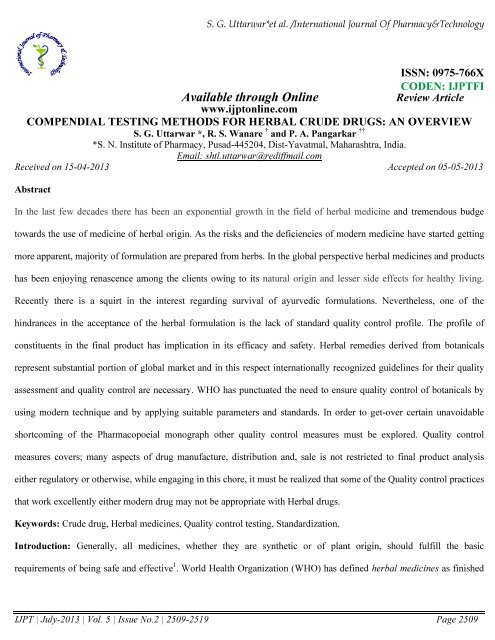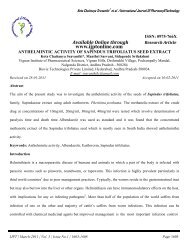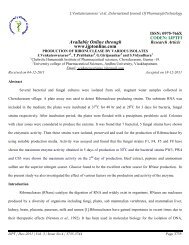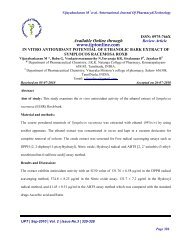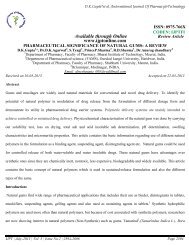Available through Online - International Journal of Pharmacy and ...
Available through Online - International Journal of Pharmacy and ...
Available through Online - International Journal of Pharmacy and ...
Create successful ePaper yourself
Turn your PDF publications into a flip-book with our unique Google optimized e-Paper software.
S. G. Uttarwar*et al. /<strong>International</strong> <strong>Journal</strong> Of <strong>Pharmacy</strong>&TechnologyISSN: 0975-766XCODEN: IJPTFI<strong>Available</strong> <strong>through</strong> <strong>Online</strong>Review Articlewww.ijptonline.comCOMPENDIAL TESTING METHODS FOR HERBAL CRUDE DRUGS: AN OVERVIEWS. G. Uttarwar *, R. S. Wanare † <strong>and</strong> P. A. Pangarkar ††*S. N. Institute <strong>of</strong> <strong>Pharmacy</strong>, Pusad-445204, Dist-Yavatmal, Maharashtra, India.Email: shtl.uttarwar@rediffmail.comReceived on 15-04-2013 Accepted on 05-05-2013AbstractIn the last few decades there has been an exponential growth in the field <strong>of</strong> herbal medicine <strong>and</strong> tremendous budgetowards the use <strong>of</strong> medicine <strong>of</strong> herbal origin. As the risks <strong>and</strong> the deficiencies <strong>of</strong> modern medicine have started gettingmore apparent, majority <strong>of</strong> formulation are prepared from herbs. In the global perspective herbal medicines <strong>and</strong> productshas been enjoying renascence among the clients owing to its natural origin <strong>and</strong> lesser side effects for healthy living.Recently there is a squirt in the interest regarding survival <strong>of</strong> ayurvedic formulations. Nevertheless, one <strong>of</strong> thehindrances in the acceptance <strong>of</strong> the herbal formulation is the lack <strong>of</strong> st<strong>and</strong>ard quality control pr<strong>of</strong>ile. The pr<strong>of</strong>ile <strong>of</strong>constituents in the final product has implication in its efficacy <strong>and</strong> safety. Herbal remedies derived from botanicalsrepresent substantial portion <strong>of</strong> global market <strong>and</strong> in this respect internationally recognized guidelines for their qualityassessment <strong>and</strong> quality control are necessary. WHO has punctuated the need to ensure quality control <strong>of</strong> botanicals byusing modern technique <strong>and</strong> by applying suitable parameters <strong>and</strong> st<strong>and</strong>ards. In order to get-over certain unavoidableshortcoming <strong>of</strong> the Pharmacopoeial monograph other quality control measures must be explored. Quality controlmeasures covers; many aspects <strong>of</strong> drug manufacture, distribution <strong>and</strong>, sale is not restricted to final product analysiseither regulatory or otherwise, while engaging in this chore, it must be realized that some <strong>of</strong> the Quality control practicesthat work excellently either modern drug may not be appropriate with Herbal drugs.Keywords: Crude drug, Herbal medicines, Quality control testing, St<strong>and</strong>ardization.Introduction: Generally, all medicines, whether they are synthetic or <strong>of</strong> plant origin, should fulfill the basicrequirements <strong>of</strong> being safe <strong>and</strong> effective 1 . World Health Organization (WHO) has defined herbal medicines as finishedIJPT | July-2013 | Vol. 5 | Issue No.2 | 2509-2519 Page 2509
S. G. Uttarwar*et al. /<strong>International</strong> <strong>Journal</strong> Of <strong>Pharmacy</strong>&Technologylabeled medicinal product that contain active ingredients, aerial or underground parts <strong>of</strong> the plant or other plant materialor combinations 2 .In all traditional systems <strong>of</strong> medicine, the quality control aspect has been considered from its inspection itself byPractitioners for effective <strong>and</strong> safe use. However, modern concept require necessary changes in their access by that wayconcrete method <strong>of</strong> quality control in terms development <strong>of</strong> modern methodologies. Hence quality assurance is hurl areafor the evaluation <strong>of</strong> botanicals <strong>and</strong> herbal formulations so utmost chore is to evolve such parameter by which thepresence <strong>of</strong> the entire ingredients can be identified. For st<strong>and</strong>ardization <strong>of</strong> herbal drugs various chromatographicpr<strong>of</strong>iles, spectrophotometric methods <strong>and</strong> evaluation <strong>of</strong> physicochemical properties can be tried to evolve pattern foridentifying the presence <strong>of</strong> different ingredient 3 .Stream Regulations for St<strong>and</strong>ardization <strong>of</strong> Crude Drugs<strong>International</strong>ly various pharmacopoeias have provided monographs stating parameters <strong>and</strong> st<strong>and</strong>ards <strong>of</strong> many herbs <strong>and</strong>herbal products to maintain their quality in their respective nations. British Herbal Pharmacopoeia British Herbal Compendium Chinese Herbal Pharmacopoeia United States Herbal Pharmacopoeia Japanese St<strong>and</strong>ards for Herbal Medicine The Ayurvedic Pharmacopoeia <strong>of</strong> India (API)Government <strong>of</strong> India besides has come out with Ayurvedic Pharmacopoeia, which recommends basic qualityparameters for eighty common Ayurvedic herbal drugs.St<strong>and</strong>ardization <strong>and</strong> Quality Control Parameters for Evaluation <strong>of</strong> Herbal Crude Drugs 4St<strong>and</strong>ardization accounting to WHO is the process involving the physicochemical evaluation <strong>of</strong> crude drug covering theaspects, as selection <strong>and</strong> h<strong>and</strong>ling <strong>of</strong> crude material, safety, efficacy <strong>and</strong> stability assessment <strong>of</strong> finished product,documentation <strong>of</strong> safety <strong>and</strong> risk based on experience, provision <strong>of</strong> product information to consumer <strong>and</strong> productpromotion.IJPT | July-2013 | Vol. 5 | Issue No.2 | 2509-2519 Page 2510
S. G. Uttarwar*et al. /<strong>International</strong> <strong>Journal</strong> Of <strong>Pharmacy</strong>&TechnologyThe quality <strong>and</strong> purity required in a drug are achieved by st<strong>and</strong>ards given in the <strong>of</strong>ficial work <strong>of</strong> reference. To establishthe identity <strong>and</strong> quality <strong>of</strong> the drug, several methods may be considered 5,6-8 .These are enumerated below,• Macroscopic Examination: In case <strong>of</strong> whole drug, the macroscopic <strong>and</strong> sensory characters are sufficient foridentification <strong>of</strong> right variety <strong>and</strong> search <strong>of</strong> adulterants.• Microscopic Examination: These are valuable both for powders <strong>and</strong> ungrounded drugs for identification <strong>of</strong>right variety <strong>and</strong> search <strong>of</strong> adulterants.• Solubility: The solubility, especially exceptional behavior towards solvent, is useful in examination <strong>of</strong> many oils<strong>and</strong> oleo-resins.• Physical constants: Physical constants such as specific gravity, optical rotation, viscosity <strong>and</strong> refractive indexare especially valuable for the evaluation <strong>of</strong> fats, oleoresins, balsams <strong>and</strong> similar substances.• Foreign Organic Matter: Remove <strong>of</strong> matter other than source plant to get the drug in pure form.• Ash Values: It is criteria to judge the identity <strong>and</strong> purity <strong>of</strong> crude drug – Total ash, sulfated ash, water solubleash <strong>and</strong> acid insoluble ash etc.• Extractive Values: These are indicating the approximate measure <strong>of</strong> chemical constituents <strong>of</strong> crude drug.• Moisture Content: To check moisture content helps prevent degradation <strong>of</strong> product.• Crude Fiber: To determine excessive woody material Criteria for judging purity.• Chromatographic Examination: Include identification <strong>of</strong> crude drug based on use <strong>of</strong> major chemicalconstituent as marker.• Qualitative Chemical Evaluation: Covers criteria for identification <strong>and</strong> characterization <strong>of</strong> crude drug withrespect to phytochemical Constituents.• Quantitative Chemical Evaluation: Covers criteria to estimate the amount <strong>of</strong> active constituents.• Volatile oils: its cover the measurement <strong>of</strong> the volatile content <strong>of</strong> the plant.• Bitterness value: The bitter properties <strong>of</strong> plant material are determined by comparing the threshold bitterconcentration <strong>of</strong> an extract <strong>of</strong> the materials with that <strong>of</strong> a dilute solution <strong>of</strong> quinine hydrochloride R.IJPT | July-2013 | Vol. 5 | Issue No.2 | 2509-2519 Page 2511
S. G. Uttarwar*et al. /<strong>International</strong> <strong>Journal</strong> Of <strong>Pharmacy</strong>&Technology• Hemolytic activity: The hemolytic activity <strong>of</strong> plant materials, or a preparation containing saponins, isdetermined by comparison with that <strong>of</strong> a reference material, saponins R.• Foaming index: The foaming ability <strong>of</strong> an aqueous decoction <strong>of</strong> plant materials <strong>and</strong> their extracts is measuredin terms <strong>of</strong> a foaming index.• Pesticide residues: it measures the pesticide residues in the plant.• Swelling index: it measures the swelling property <strong>of</strong> the medicinal plant.• Arsenic <strong>and</strong> heavy metals: Contamination <strong>of</strong> medicinal plant materials with arsenic <strong>and</strong> heavy metals can beattributed to many causes including environmental pollution <strong>and</strong> traces <strong>of</strong> pesticides.• Microorganisms: Current practices <strong>of</strong> harvesting, h<strong>and</strong>ling <strong>and</strong> production may cause additional contamination<strong>and</strong> microbial growth.• Alfatoxins: Minute presence in crude drug can be toxic <strong>and</strong> hence their presence is being tested.• Chemical Fingerprinting: To allow the detection <strong>of</strong> all the components in extracts.• DNA Fingerprinting: Technique is useful for identification <strong>of</strong> phytochemically indistinguishable genuine drugfrom substituted or adulterate drug.• Biological pr<strong>of</strong>iling: It identifies the biologically active plants allowing highly sophisticated st<strong>and</strong>ardization <strong>and</strong>quality control.• Radioactive contamination: A certain amount <strong>of</strong> exposure to ionizing radiation cannot be avoided since thereare many sources, including radio nuclides occurring naturally in the ground <strong>and</strong> the atmosphere.• Toxicological Studies: To help to determine pesticide residue, potentially toxic elements, safety studies inanimals like LD50 <strong>and</strong> Microbial count approach to ascertain their presence or absence.The processes mentioned above involves wide array <strong>of</strong> scientific investigations, which include physical, chemical<strong>and</strong> biological evaluation employing various analytical methods <strong>and</strong> tools. The specific aims <strong>of</strong> such investigation inassuring herbal quality are as varied as the processes employed 9 .IJPT | July-2013 | Vol. 5 | Issue No.2 | 2509-2519 Page 2512
Physical evaluation 2S. G. Uttarwar*et al. /<strong>International</strong> <strong>Journal</strong> Of <strong>Pharmacy</strong>&TechnologyEach monograph contains detailed botanical, macroscopic <strong>and</strong> microscopic descriptions <strong>of</strong> the physical characteristics <strong>of</strong>each plant that can be used to ensure both identity <strong>and</strong> purity. Each description is accompanied by detailed illustrations<strong>and</strong> photographic images which provide visual documentation <strong>of</strong> accurately identified material. Various physicalparameters include viscosity, volatile matter content, density, refractive index, hemolytic activity, foaming index,melting point, solubility. The Q. C. Parameter for evaluation <strong>of</strong> crude drug Moisture content Specific gravity Opticalrotation Bitterness value Swelling index, Ash value.Microscopic evaluation 3Microscopic analyses <strong>of</strong> plants are invaluable for assuring the identity <strong>of</strong> the material <strong>and</strong> as an initial screening test forimpurities. Most manufacturers <strong>of</strong> herbal products lack the quality control personnel to accurately assess plant identity<strong>and</strong> purity microscopically. The Ayurvedic Herbal Pharmacopoeia (AHP) fully characterizes herbal products against theliterature <strong>and</strong> AHP verified trade mark authenticated materials to assure identity <strong>of</strong> test materials. Ideally, submittedmaterials should be in their whole or semi-whole (cut) form for microscopic assessment. However, much informationcan be discerned from microscopic evaluation <strong>of</strong> powders as well. Full <strong>and</strong> accurate characterization <strong>of</strong> plant materialrequires a combination <strong>of</strong> physical <strong>and</strong> chemical tests.Chemical evaluation 9This covers the screening, isolation, identification <strong>and</strong> purification <strong>of</strong> chemical components. Chemical analysis <strong>of</strong> thedrug is done to assess the potency <strong>of</strong> vegetable <strong>and</strong> animal source material in terms <strong>of</strong> their active principles. Thechemical screening include colour reaction test, which help to determine the identity <strong>of</strong> the drug substance <strong>and</strong> possibleadulteration.Biological evaluationPharmacological activity <strong>of</strong> certain drugs has been applied to evaluate <strong>and</strong> st<strong>and</strong>ardize them. The assays on livinganimal <strong>and</strong> on their intact or isolated organs can indicate the strength <strong>of</strong> the drug or their preparations. All livingorganism are used, these assays are known as Biological assays or Bioassay 14 .IJPT | July-2013 | Vol. 5 | Issue No.2 | 2509-2519 Page 2513
Analytical Methods 9S. G. Uttarwar*et al. /<strong>International</strong> <strong>Journal</strong> Of <strong>Pharmacy</strong>&TechnologyCritical to compliance with any monograph, st<strong>and</strong>ard is the need for appropriate analytical methods for determiningidentity, quality, <strong>and</strong> relative potency. There are a plethora <strong>of</strong> analytical methods available. However, it is <strong>of</strong>ten difficultto know which is the most appropriate to use. The primary goal <strong>of</strong> AHP is to provide multiple methods <strong>of</strong> identification<strong>and</strong> testing by which all aspects <strong>of</strong> the botanical can be appropriately assayed.Chromatographic Characterization 5,9Chromatography is the science which studies the separation <strong>of</strong> molecules based on differences in their structure <strong>and</strong>/orcomposition. In general, chromatography involves moving a preparation <strong>of</strong> the materials to be separated, “the "testpreparation”, over a stationary support. The molecules in the test preparation will have different interactions with thestationary support leading to separation <strong>of</strong> similar molecules. Test molecules which display tighter interactions with thesupport will tend to move more slowly <strong>through</strong> the support than those molecules with weaker interactions. In this way,different types <strong>of</strong> molecules can be separated from each other as they move over the support material. Chromatographicseparations can be carried out using a variety <strong>of</strong> supports, including immobilized silica on glass plates (thin layerchromatography), very sensitive High Performance Thin Layer Chromatography (HPTLC), volatile gases (gaschromatography), paper (paper chromatography), <strong>and</strong> liquids which may incorporate hydrophilic, insoluble molecules(liquid chromatography).High performance thin layer chromatography (HPTLC) is a valuable quality assessment tool for the evaluation <strong>of</strong>botanical materials. It allows for the analysis <strong>of</strong> a broad number <strong>of</strong> compounds both efficiently <strong>and</strong> cost effectively.Additionally, numerous samples can be run in a single analysis thereby dramatically reducing analytical time. WithHPTLC, the same analysis can be viewed collectively in different wavelengths <strong>of</strong> light thereby providing a morecomplete pr<strong>of</strong>ile <strong>of</strong> the plant than is typically observed with more specific type <strong>of</strong> analysis.10, 11-13DNA FingerprintingDNA analysis has been proved as an important tool in herbal drug st<strong>and</strong>ardization. This technique is useful for theidentification <strong>of</strong> phytochemically indistinguishable genuine drug from substituted or adulterated drug. It has beenreported that DNA fingerprint genome remain the same irrespective <strong>of</strong> the plant part used while the phytochemicalIJPT | July-2013 | Vol. 5 | Issue No.2 | 2509-2519 Page 2514
S. G. Uttarwar*et al. /<strong>International</strong> <strong>Journal</strong> Of <strong>Pharmacy</strong>&Technologycontent will vary with the plant part used, physiology <strong>and</strong> environment 10 . Deoxyribonucleic acid (DNA) is thefundamental building component <strong>of</strong> all living cells. Our characteristics, traits <strong>and</strong> physical features are determined bythe specific arrangement <strong>of</strong> DNA base-pair sequences in the cell. It is this distinct arrangement <strong>of</strong> adenine, guanine,thymine <strong>and</strong> cytosine (called DNA nucleotides) that regulates the production <strong>of</strong> specific proteins <strong>and</strong> enzymes via theCentral Dogma Theory. Central Dogma theory can be defined as the fundamental theory <strong>of</strong> molecular biology thatgenetic information flows from DNA to RNA to proteins 11 . This concept <strong>of</strong> fingerprinting has been increasingly appliedin the past few decades to determine the ancestry <strong>of</strong> plants, animals <strong>and</strong> other microorganisms. Genotypiccharacterization <strong>of</strong> plant species <strong>and</strong> strains is useful as most plants, though belonging to the same genus <strong>and</strong> species,may show considerable variation between strains. Additional motivation for using DNA fingerprinting on commercialherbal drugs is the availability <strong>of</strong> intact genomic DNA from plant samples after they are processed. Adulterants can bedistinguished even in processed samples, enabling the authentication <strong>of</strong> the drug 12 . The other useful application <strong>of</strong> DNAfingerprinting is the availability <strong>of</strong> intact genomic DNA specificity in commercial herbal drugs which helps indistinguishing adulterants even in processed samples 13 .Purity DeterminationEach monograph includes st<strong>and</strong>ards <strong>of</strong> purity <strong>and</strong> other qualitative assessments which include when appropriate: foreignmatter, ash, acid-insoluble ash, moisture content, loss <strong>of</strong> moisture on drying, <strong>and</strong> extractives.High performance thin layer chromatography (HPTLC) is valuable quality assessment tool for the evaluation <strong>of</strong>botanical materials. It allows for the analysis <strong>of</strong> a broad number <strong>of</strong> compounds both efficiently <strong>and</strong> cost effectively.Additionally, numerous samples can be run in a single analysis thereby dramatically reducing analytical time. WithHPTLC, the same analysis can be viewed sing different wavelengths <strong>of</strong> light thereby providing a more complete pr<strong>of</strong>ile<strong>of</strong> the plant than is typically observed with more specific types <strong>of</strong> analyses 15 .Quantitative AnalysisPrimary factors for considering a method as appropriate include accuracy <strong>of</strong> the findings, speed, basic ruggedness,applicability to a large segment <strong>of</strong> the manufacturing community, <strong>and</strong> avoidance <strong>of</strong> the use <strong>of</strong> toxic reagents <strong>and</strong>solvents. In an attempt to promote harmonization, primary consideration is given to those methods which are alreadyIJPT | July-2013 | Vol. 5 | Issue No.2 | 2509-2519 Page 2515
S. G. Uttarwar*et al. /<strong>International</strong> <strong>Journal</strong> Of <strong>Pharmacy</strong>&Technologyaccepted in <strong>of</strong>ficial pharmacopoeias or by AOAC <strong>International</strong>. The validation process minimally includes: st<strong>and</strong>ardprecision, linearity, sample precision using replicate samples, sample linearity, selectivity (co-elution, sensitivity toanalyte degradation), retention times, <strong>and</strong> limits <strong>of</strong> detection. Other methods which may be <strong>of</strong> value to the industry maybe included or cited in the monograph but are not required for compliance with the monograph.Who Guidelines for Quality St<strong>and</strong>ardized Herbal FormulationsSt<strong>and</strong>ardization <strong>and</strong> quality control parameters for herbal formulations are based on following fundamental parameters:1. Quality control <strong>of</strong> crude drugs material, plant preparations <strong>and</strong> finished products.2. Stability assessment <strong>and</strong> shelf life.3. Safety assessment; documentation <strong>of</strong> safety based on experience or toxicological studies.4. Assessment <strong>of</strong> efficacy by ethno medical information <strong>and</strong> biological activity evaluations.Quality Control <strong>of</strong> Crude MaterialAccording to pharmaceutical manufacturers association <strong>of</strong> U.S. “quality is the sum <strong>of</strong> all the factors which contributedirectly or indirectly to the safety, effectiveness <strong>and</strong> acceptability <strong>of</strong> the product” 4 . St<strong>and</strong>ardization describes allmeasures taken during manufacturing process <strong>and</strong> quality control leads to reproducible quality <strong>of</strong> particular product.St<strong>and</strong>ardization <strong>of</strong> botanicals <strong>of</strong>fers many obstacles because synthetic drugs have well defined structure <strong>and</strong> otheranalytical parameters as well as reference st<strong>and</strong>ard for comparison also established assays <strong>and</strong> pharmacopoeias.Therefore, quality control is not problematic for synthetic drug 15 . There are several challenges as st<strong>and</strong>ardization <strong>of</strong>herbal product is considered like controversial identity <strong>of</strong> various plants, deliberated adulteration <strong>of</strong> plant material,problems in storage <strong>and</strong> transport, which should be considered 16 .One <strong>of</strong> the impediments in the acceptance <strong>of</strong> the herbalproducts worldwide is the lack <strong>of</strong> st<strong>and</strong>ard quality control pr<strong>of</strong>iles. Most <strong>of</strong> the herbal formulations, especially theclassical formulations <strong>of</strong> traditional medicine, are polyherbal. In the United States, herbs are used either as dietarysupplements, with minimal st<strong>and</strong>ards <strong>of</strong> safety <strong>and</strong> efficacy, or as drugs, which require expensive <strong>and</strong> cumbersometesting procedures.Validation: In order to control quality <strong>of</strong> herbal drugs in better way, we must amalgamate newer techniques <strong>and</strong> termsto maximum extent. USFDA defines validation as, “Validation is documented evidence which provides a high degree <strong>of</strong>IJPT | July-2013 | Vol. 5 | Issue No.2 | 2509-2519 Page 2516
S. G. Uttarwar*et al. /<strong>International</strong> <strong>Journal</strong> Of <strong>Pharmacy</strong>&Technologyassurance that a specific process will consistently produce a product meeting its predefined specifications <strong>and</strong> qualityattributes”.Generally, validation investigations must include studies on specificity, linearity, accuracy, precision, range, detection,<strong>and</strong> quantitative limits, depending on whether the analytical method used is qualitative or quantitative 17 . Also, <strong>of</strong> utmostimportance is the availability <strong>of</strong> st<strong>and</strong>ards. For macroscopic <strong>and</strong> microscopic procedures in general this means thatreliable reference samples <strong>of</strong> the plant must be available. A defined botanical source (e.g. voucher specimens) willnormally solve this problem. This concept <strong>of</strong> validation is getting well applied to manufacturing <strong>of</strong> synthetic drugs fromlong time back. But yet not methodically studied <strong>and</strong> applied for the manufacturing <strong>of</strong> herbal drugs. <strong>International</strong>regulations like USFDA, MCC, MHRA, TGA etc. shows the applicability <strong>of</strong> validation to pharmaceuticalmanufacturing but no one regulation except WHO applies the validation concept to manufacturing <strong>of</strong> herbal drugs.WHO also emphasize on very little part <strong>of</strong> validation. Due to aforesaid reason the emphasis on the concept <strong>of</strong> validation<strong>and</strong> also the validation model for manufacturing <strong>of</strong> herbal drugs should be the need <strong>of</strong> time.Validation Model for Manufacturing <strong>of</strong> Herbal drugsThere are lots <strong>of</strong> parameters which has to be considered while certifying the manufacturer the type <strong>of</strong> herbs as,• Environmental <strong>and</strong> growing conditions.• Time <strong>of</strong> harvesting.• Variation in composition.• Drying <strong>of</strong> herbal drugs.• Packaging <strong>of</strong> herbal formulations.ConclusionBecause <strong>of</strong> sobriety <strong>of</strong> the problem, fundamental knowledge <strong>of</strong> the important herbs found in India <strong>and</strong> widely used inAyurvedic formulation along with new st<strong>and</strong>ardization techniques is <strong>of</strong> prime importance <strong>and</strong> be explored.Incorporation <strong>of</strong> this will authenticate quality thereby reducing further problems. The development <strong>of</strong> modern analyticaltools in testing the various quality parameters for an effective quality control herbal product cannot be over emphasized.The assurance <strong>of</strong> the safety <strong>and</strong> efficacy <strong>of</strong> herbal drug requires monitoring <strong>of</strong> the quality <strong>of</strong> the product from collectionIJPT | July-2013 | Vol. 5 | Issue No.2 | 2509-2519 Page 2517
S. G. Uttarwar*et al. /<strong>International</strong> <strong>Journal</strong> Of <strong>Pharmacy</strong>&Technology<strong>through</strong> processing to the finished packaged product. Our view is to draw the attention <strong>of</strong> readers to the rapidly evolvingst<strong>and</strong>ardization aspects <strong>of</strong> herbal drugs with some new trends, so the area could be exp<strong>and</strong>ed significantly <strong>and</strong> minimizequality infract.References1. EMEA (2005). Guidelines on Quality <strong>of</strong> Herbal Medicinal Products/Traditional Medicinal Products,EMEA/CVMP/814OO Review. European Agency for the Evaluation <strong>of</strong> Medicinal Products (EMEA), London.2. Agarwal, A., 2005. Critical issues in Quality Control <strong>of</strong> Herbal Products, Pharma Times, 37(6), pp 09-11.3. Sane, R.T., 2002. St<strong>and</strong>ardization, Quality Control <strong>and</strong> GMP for Herbal drugs, Indian Drugs, 39 (3), pp 184-190.4. Florey, H. W., Chain, E. <strong>and</strong> Florey, M. E., 1949. Vol. 1. The antibiotic, Oxford University Press. New York, pp576-628.5. Quality Control <strong>of</strong> Herbal Drugs, Pulok K Mukherjee , Business Horizons Pharmaceutical publishers, 2002, pp 186-245.6. Hyl<strong>and</strong>s P. New approaches for the quality control <strong>and</strong> st<strong>and</strong>ardization <strong>of</strong> plant delivered pharmaceutical <strong>and</strong>nutraceutical products. Oxford: Oxford Natural Products Publications. 20027. Indian Pharmacopoeia-2007, Ministry <strong>of</strong> health <strong>and</strong> Family Welfare, Controller <strong>of</strong> Publication, Delhi, Vol -III, pp2015-2073.8. Evans WC.Techniques in microscopy: quantitative microscopy.A Textbook <strong>of</strong> Pharmacognosy. 14 ed. /London:WB Saunders bCompany Ltd. 1996, pp 568-5789. Kunley, Oluyemisi F. St<strong>and</strong>ardisation <strong>of</strong> herbal medicines.A review, <strong>International</strong> journal <strong>of</strong> biodiversity <strong>and</strong>conservation vol 4(3), March 2012, pp 101-112.10. Shikha S, Mishra N. Genetic markers - a cutting-edge technology in herbal drug research. J Chem Pharm Res 2009,vol 1, pp 1-18.11. Breithaupt,. H. (2003) Back to the roots EMBO Rep 4(1), pp 10-12.12. Mihalov, J. J., Marderosian, A. D., <strong>and</strong> Pierce, J. C. DNA identification <strong>of</strong> commercial ginseng samples, 2000.IJPT | July-2013 | Vol. 5 | Issue No.2 | 2509-2519 Page 2518
S. G. Uttarwar*et al. /<strong>International</strong> <strong>Journal</strong> Of <strong>Pharmacy</strong>&Technology13. Lazarowych NJ, Pekos P. The use <strong>of</strong> fingerprint <strong>and</strong> marker compounds for identification <strong>and</strong> st<strong>and</strong>ardization <strong>of</strong>botanical drugs. J Drug Inform 1998, 32, pp 497-512.14. Chaudhari, R. D., 1996. Herbal drug industry, 1 st Edn., Eastern Publisher, New Delhi, 498-499.15. Chakravarthy, B. K., 1993. St<strong>and</strong>ardization <strong>of</strong> Herbal products. Indian. J. Nat. Product,vol 9, pp 23-26.16. Bhanu P. S., Sagar, T. K. <strong>and</strong> R. Zafer., 2003. Failure <strong>and</strong> successes <strong>of</strong> Herbal Medicines, The Indian Pharmacist, pp17-23.17. De Smet PAGM, Keller K, Hansel R, Ch<strong>and</strong>ler RF (1997). Adverse Effects <strong>of</strong> Herbal Drugs, (eds), Springer-Verlag,Heidelberg. vol 129(3), pp 137-145.Corresponding Author:S. G. Uttarwar *,Email: shtl.uttarwar@rediffmail.comIJPT | July-2013 | Vol. 5 | Issue No.2 | 2509-2519 Page 2519


